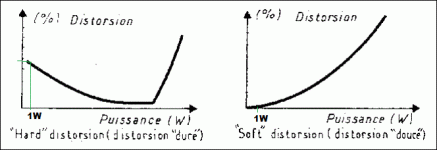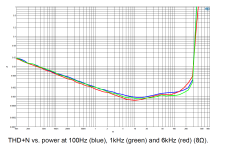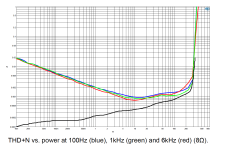But what if it has other issues? We had a case on this site recently where an amps compensation components were being tweaked for lowest distortion but there was no loop gain analysis (1.1 ppm down to 800 ppm IIRC).Explain all you like its not a fact. Any amp with very low distortion is faithful to its input, the amp's only job (other than to amplify!). ITs a crude measure, but its a necessary baseline to start from. Do the maths...
If we follow your logic, a 1 ppm distortion amp is more faithful than a 10 pmm distortion amp even if the 1 ppm one has problems that the 10 ppm one does not. That’s the primary reason for kicking this thing off that’s got a lot of people unhappy it seems.
A good quality amp will not have stability problems, it will drive a complex speaker load without issues, have basic protection mechanisms and have low noise, not suffer rail sticking, burst oscillation or slew rate limiting i.a.o.
Ranking amplifiers with a one dimensional THD figure misses all the other stuff that designers should attend to.
As to how an amp sounds, that’s anyone’s guess but telling you what does and does not sound good is not part of this rating system. That’s for the listener to decide.
Phono preamps aside, no, but most 0.001% amps are razor flat in response for the same reason they have low harmonic distortion, the feedback network is basically two decent metal-film resistors, defining both the linearity and the flat frequency response.
Many have an output inductor that spoils the frequency response when you connect a loudspeaker, or a built-in high-pass filter of some sort, or a built-in low-pass filter, or all of those. It is very unusual for an amplifier to have a response that is flat within 0.1 dB from 16 Hz to 20 kHz with a loudspeaker connected.
I mention frequency response because according to PMA, it's the only thing that is often bad enough to be noticed in double-blind tests, assuming the amplifier doesn't clip. Still, many amplifier threads here concentrate on non-linear distortion measures and neglect frequency response - phono preamplifiers excepted.
The scoring/rating system was put up and people have been asked to comment on it. Are some parameters too tight, others too loose?Agreed by whom? Clear to whom?
Perhaps it's a difference in a translation? I would say that statement is categorically false. I also consider you one of the smartest folks around. So, perhaps we're using different definitions.
What I mean by objective is:
- "(of a person or their judgment) not influenced by personal feelings or opinions in considering and representing facts."
What I mean by subjective is:
- "based on personal opinions and feelings rather than on facts."
Your entire scoring and weighting system is / will be based upon opinion. Whether that opinion is shared by many and then thrust upon (told) to those whose products might be scored, does not make it any less subjective. Taking an objective measurement result and assigning a weighting or score to it based on an opinion makes it subjective. That has been clearly pointed out to you repeatedly.
With how many discussions there are around objective vs. subjective perhaps it would lower the noise if you told us what specifically you mean by those terms. Your definition can stand throughout the rest of the thread, but we'll at least understand your POV re: subjective and objective more clearly. Perhaps you'll convince me to use a different definition or to understand how your entire system is not a matter of opinion.
Remember, the scoring is looking at hard engineering parameters for the most part - it is not looking at assessing subjective parameters like sound quality or PRaT etc. Assigning scores that I had hoped would be discussed in a constructive manner to measurable performance metrics is hardly one individuals subjective view is it?
^ I feel like I understand you, which is the most important aspect. Me continuing to harp on what's subjective vs. objective doesn't really help you. I thought it was possibly causing some strife with others also, but it may just be my own hang-up.
I know what you mean, and I think I understand your overall intent.
The semantics are no longer important (to me).
I just want to see the "score" or whatever it may be called reflect YOUR (or a committee's) actual intent. I think I've made a few points re: what I'd prefer. If those suggestions aren't incorporated, I really am good with that. It didn't stop me from trying one more time... but now... it's going to be what it's going to be. I'll support however it turns out. I won't throw the baby out with the bathwater. It's going to be very useful, IMO.
Cheers,
Patrick
I know what you mean, and I think I understand your overall intent.
The semantics are no longer important (to me).
I just want to see the "score" or whatever it may be called reflect YOUR (or a committee's) actual intent. I think I've made a few points re: what I'd prefer. If those suggestions aren't incorporated, I really am good with that. It didn't stop me from trying one more time... but now... it's going to be what it's going to be. I'll support however it turns out. I won't throw the baby out with the bathwater. It's going to be very useful, IMO.
Cheers,
Patrick
You all asked for input and comments.Where do,you get the idea that there is a ‘panel’? There is no panel. There is no ‘reference system‘. What is going to get measured is what is in discussion.
No one is forcing you to submit your amplifier to anyone for review and no one is imposing this assessment framework on you. If you do not want to participate then don’t - if you have a system for assessing your amplifier in place with an experienced listening panel then please use it but don’t raise objections about this one that do not exist.
If your interest is in why it sounds better then feel free to start your own discussion group.
If you don't want input and comments and don't want to read other people's posts... then, maybe you should NOT ask for input and comments.
Yikes.
The scoring/rating system was put up and people have been asked to comment on it. Are some parameters too tight, others too loose?
Main problem is the confusion, FI slew rate is a parameter that has nothing to do with performance, it s a parameter comparable to input sensitivity and its eventual influence on performances will appear through other measurements, namely IMD if the slew rate is too low, that s comparable to a high input sensitivity that will result eventually as an excessive output noise...
As an exemple of the drawbacks of your ratings an amp A with 0.1% IMD but with 200V/us SR will be granted a better rating than an amp B with 20V/us and 0.03% IMD, yet the latter s 0.03% IMD number is the prove that amp B slew rate is more than sufficent and that pursuing a higher slew rate for amp A was actually chasing the wrong deficiencies.
So before doing a rating it would be usefull to check the relevance of the parameters at work, otherwise you ll be left manipulating real but also hollow numbers that have no significance in isolation.
Frequency response into complex load (realworld speaker load) is by far the best single parameter to characterize amplifier “fidelity” with regard to sound reproduction for human listener. Metrics is easy, deviation from straight line.
Agree on both terms. Specify a test that nails the first one and add it to the "current" suite + eventual other new ones.A good quality amp will not have stability problems, it will drive a complex speaker load without issues, have basic protection mechanisms and have low noise, not suffer rail sticking, burst oscillation or slew rate limiting i.a.o.
Ranking amplifiers with a one dimensional THD figure misses all the other stuff that designers should attend to.
Make a combined figure of merit.
//
How about ditching the point-based rating alltogether? The assessment program is a valid tool for diy even without any ratings especially if the measurement procedures and equipment are well described. Ratings could be replaced with textual description of what is considered good and bad and exemplified e.g. by measurements of good and bad DUTs.
Slew rate was replaced with IMD in the metrics about 4 pages back. Read the document in the first post.Main problem is the confusion, FI slew rate is a parameter that has nothing to do with performance, it s a parameter comparable to input sensitivity and its eventual influence on performances will appear through other measurements, namely IMD if the slew rate is too low, that s comparable to a high input sensitivity that will result eventually as an excessive output noise...
As an exemple of the drawbacks of your ratings an amp A with 0.1% IMD but with 200V/us SR will be granted a better rating than an amp B with 20V/us and 0.03% IMD, yet the latter s 0.03% IMD number is the prove that amp B slew rate is more than sufficent and that pursuing a higher slew rate for amp A was actually chasing the wrong deficiencies.
So before doing a rating it would be usefull to check the relevance of the parameters at work, otherwise you ll be left manipulating real but also hollow numbers that have no significance in isolation.
Relevance of parameters is better than just THD don’t you think?
Your comments are unrelated to what the assessment proposes.You all asked for input and comments.
If you don't want input and comments and don't want to read other people's posts... then, maybe you should NOT ask for input and comments.
Yikes.
If you want a system that looks at sound quality with listener panel that’s fine but that’s not what this is about.
Examples of complex load influence on frequency response of the amplifier with very low output impedance (high DF, damping factor)
First, load impedance magnitude, phase, resistance and EPDR

Effect on amplitude response (y-axis dB relative to ADC FS input range), compared to 4R7 resistor load
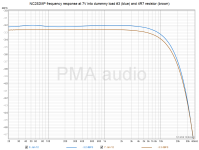
(negligible)
Effect on phase response, compared to 4R7 resistor load
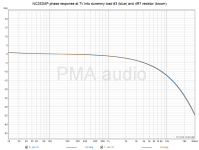
(negligible)
Effect on THD vs. frequency, compared to 4R7 resistor load
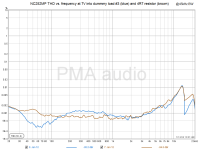
(reflects EPDR and resistance of the load)
First, load impedance magnitude, phase, resistance and EPDR

Effect on amplitude response (y-axis dB relative to ADC FS input range), compared to 4R7 resistor load

(negligible)
Effect on phase response, compared to 4R7 resistor load

(negligible)
Effect on THD vs. frequency, compared to 4R7 resistor load

(reflects EPDR and resistance of the load)
How about ditching the point-based rating alltogether? The assessment program is a valid toolfor diyeven without any ratings especially if the measurement procedures and equipment are well described. Ratings could be replaced with textual description of what is considered good and bad and exemplified e.g. by measurements of good and bad DUTs.

Edited for adding one piece of emphasis...
Last edited:
Even if the amp have 0.01% or 0,0001% THD I think is important parameter how that dynamic distortion is developed in function of output power , special inside of the First Watt area.
The plots are obsolete nowadays. None of the well designed amplifiers will have such low idle current and such high crossover distortion as shown in Hiraga image. We are not discussing toys here. Jean Hiraga has done not very good service to audio community with his misleading articles. Worse, he shows no dB or % on Y-axis.
Well designed amplifier measures like this
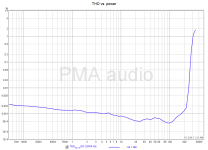
You do not need rise of distortion with power. Both Hiraga or Pass amplifiers, beloved by audiophiles, will have higher THD even at low power. And even this measurement shown is limited by system noise at low power, not by amplifier distortion.
PMA
regarding to my atachment from my post # 432 I think that there Hiraga was very right , but I admit that your diagram show THD plot of one fairly good designed amp , on the other hand many and most of other AB or D class comercial amps don`t shows such relative linear THD charachteristic , here`s the diagram example of modern Hypex NC502mp D-class amp , (second diagram is corrected by me ) .
btw, Personally, if I am in a position to choose between two amplifiers where one has a THD of 0.001% but with a worse percentage of distortion within the first watt and the other amplifier which has a THD of 0.1% but with insignificant distortion within the first watt, I would certainly choose the latter.
regarding to my atachment from my post # 432 I think that there Hiraga was very right , but I admit that your diagram show THD plot of one fairly good designed amp , on the other hand many and most of other AB or D class comercial amps don`t shows such relative linear THD charachteristic , here`s the diagram example of modern Hypex NC502mp D-class amp , (second diagram is corrected by me ) .
btw, Personally, if I am in a position to choose between two amplifiers where one has a THD of 0.001% but with a worse percentage of distortion within the first watt and the other amplifier which has a THD of 0.1% but with insignificant distortion within the first watt, I would certainly choose the latter.
Attachments
Examples of complex load influence on frequency response of the amplifier with very low output impedance (high DF, damping factor)
Same plots as in post #433, now for class AB amplifier that has wider frequency response, but also higher output impedance.
@Bonsai : Andrew, may I kindly ask you how would these amps be scaled by your score rating? 😉
One can see that distortion of the Hypex class D amplifier in post #433 is much less affected by load complex impedance. Interaction of complex load and class AB output stage.
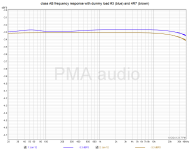
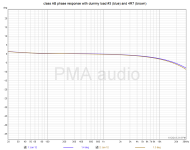
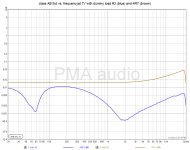
Last edited:
here`s the diagram example of modern Hypex NC502mp D-class amp , (second diagram is corrected by me ) .
Please let us not mix THD vs. power and THD+N vs. power plots. The later are always dominated by noise at low power. The former may be dominated by noise as well, but that coming from a measuring system.
Who's "we"? You and Andrew? Are you suggesting to only include "modern" / "good" designs / only commercial designs? I saw tube amps were included. Many of them have a rise in distortion with power. Are they "toys"? Many people own and use them daily, is it not valuable to understand the characteristics of what's in the existing market?We are not discussing toys here.
What exactly do you mean?
The plots are obsolete nowadays.
Why? If those plots most clearly show what you describe as (paraphrasing) poor performance and/or bad design, they seem to be an ideal format for displaying those design faults / characteristics, no?
Your argument seems counter-intuitive if I follow it properly -
- We're attempting to create a program to discern well-designed amplifiers from poorly-designed amplifiers and rate them.
- These types of plots can clearly indicate the behavior of a poorly designed amplifier
- So, they're obsolete
This is an interesting example of how a debate about "impedance FR" and that in general, it seems that a linear one is touted - but how about the above situation - would "we" prefer a linear one before a varying one that i always lower than the linear?Same plots as in post #433, now for class AB amplifier that has wider frequency response, but also higher output impedance.
@Bonsai : Andrew, may I kindly ask you how would these amps be scaled by your score rating? 😉
One can see that distortion of the Hypex class D amplifier in post #433 is much less affected by load complex impedance. Interaction of complex load and class AB output stage.
View attachment 1259097 View attachment 1259098 View attachment 1259099
Which expose the best engineering made?
Q: If you have a varying impedance the remedy is simple - just add in series, an impedance that is slightly larger than the varying so that the variations are swamped... Is this good engineering?
Just as with overtone spectrum.. say you have an amp with an N of -120 dB and with a 2:nd @ -115, 3rd@ -110, 4th@-105 and the nothing more - now, in the input stage of the amp, you add a distortion generator that injects N-> -104dB, 2nd-> -100, 3rd->-95, 4th->-90 and then nothing - now it has the wonderful falling levels of distortion - is this good engineering.
//
- Home
- Amplifiers
- Solid State
- AFOM: An attempt at an objective assessment of overall amplifier quality
